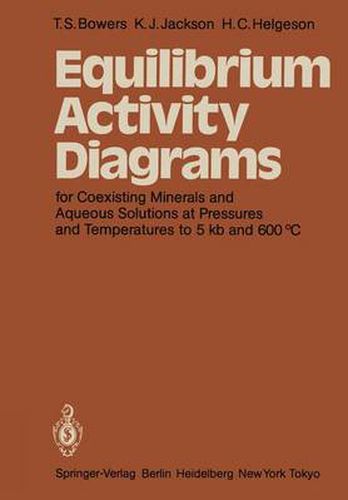Readings Newsletter
Become a Readings Member to make your shopping experience even easier.
Sign in or sign up for free!
You’re not far away from qualifying for FREE standard shipping within Australia
You’ve qualified for FREE standard shipping within Australia
The cart is loading…






This title is printed to order. This book may have been self-published. If so, we cannot guarantee the quality of the content. In the main most books will have gone through the editing process however some may not. We therefore suggest that you be aware of this before ordering this book. If in doubt check either the author or publisher’s details as we are unable to accept any returns unless they are faulty. Please contact us if you have any questions.
This book represents a revision and expansion of an earlier set of diagrams for tempera 0 0 tures from 25 to 300 C along the equilibrium vapor-liquid curve for H 0 (Helgeson, Brown, 2 and Leeper, 1969). The activity diagrams summarized in the following pages were generated over a six year period from 1977 to 1983 in the Laboratory of Theoretical Geochemistry (oth erwise known as Prediction Centra!) at the University of California, Berkeley. They represent the culmination of research efforts to generate a comprehensive and internally consistent set of thermodynamic data and equations for minerals, gases, and aqueous solutions at high pres sures and temperatures. Among the many who contributed to the successful completion of this book, we are especially indebted to David Kirkham, John Walther, and George Flowers, who wrote program SUPCRT, Tom Brown, who created program DIAGRAM, and Eli Mess inger, who generated the Tektronix plot routine to construct the diagrams. Ken Jackson and Terri Bowers both devoted an enormous amount of time and effort over the past six years to produce the diagrams in the following pages; some of which went through many stages of revision. Consequently, they appear as senior authors of this volume. It should be mentioned in this regard that their equal dedication to the project made it necessary to determine their order of authorship by flipping a coin.
$9.00 standard shipping within Australia
FREE standard shipping within Australia for orders over $100.00
Express & International shipping calculated at checkout
This title is printed to order. This book may have been self-published. If so, we cannot guarantee the quality of the content. In the main most books will have gone through the editing process however some may not. We therefore suggest that you be aware of this before ordering this book. If in doubt check either the author or publisher’s details as we are unable to accept any returns unless they are faulty. Please contact us if you have any questions.
This book represents a revision and expansion of an earlier set of diagrams for tempera 0 0 tures from 25 to 300 C along the equilibrium vapor-liquid curve for H 0 (Helgeson, Brown, 2 and Leeper, 1969). The activity diagrams summarized in the following pages were generated over a six year period from 1977 to 1983 in the Laboratory of Theoretical Geochemistry (oth erwise known as Prediction Centra!) at the University of California, Berkeley. They represent the culmination of research efforts to generate a comprehensive and internally consistent set of thermodynamic data and equations for minerals, gases, and aqueous solutions at high pres sures and temperatures. Among the many who contributed to the successful completion of this book, we are especially indebted to David Kirkham, John Walther, and George Flowers, who wrote program SUPCRT, Tom Brown, who created program DIAGRAM, and Eli Mess inger, who generated the Tektronix plot routine to construct the diagrams. Ken Jackson and Terri Bowers both devoted an enormous amount of time and effort over the past six years to produce the diagrams in the following pages; some of which went through many stages of revision. Consequently, they appear as senior authors of this volume. It should be mentioned in this regard that their equal dedication to the project made it necessary to determine their order of authorship by flipping a coin.